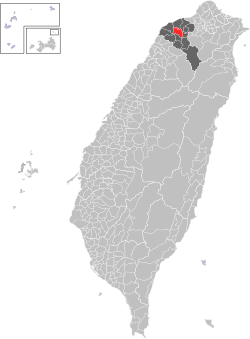Zhongli District
|
Zhongli 中壢區 |
|
|---|---|
| District | |
| Zhongli District | |

Clockwise from top left: Zhongli night skyline, day skyline, 2012 Dec 31 at HSR, Zhongli city library. Center: Zhongli night market
|
|
 |
|
| Coordinates: 24°57′25″N 121°13′25″E / 24.95694°N 121.22361°ECoordinates: 24°57′25″N 121°13′25″E / 24.95694°N 121.22361°E | |
| Country | Taiwan |
| Municipality | Taoyuan City |
| Area | |
| • Total | 76.52 km2 (29.54 sq mi) |
| Population (January 2017) | |
| • Total | 397,083 |
| • Density | 5,200/km2 (13,000/sq mi) |
| Postal code | 320 |
| Area code(s) | (0)34 |
| Website | www |
| Zhōngli District | |||||||||||||||||||||||||||
| Traditional Chinese | |||||||||||||||||||||||||||
|---|---|---|---|---|---|---|---|---|---|---|---|---|---|---|---|---|---|---|---|---|---|---|---|---|---|---|---|
| Simplified Chinese | |||||||||||||||||||||||||||
|
|||||||||||||||||||||||||||
| Transcriptions | |
|---|---|
| Standard Mandarin | |
| Hanyu Pinyin | Zhōnglì Shì |
| Bopomofo | ㄓㄨㄥ ㄌ一ˋ ㄑㄩ |
| Gwoyeu Romatzyh | Jonglih Shyh |
| Wade–Giles | Chung¹-li⁴ Shih⁴ |
| Tongyong Pinyin | Jhonglì Shìh |
| MPS2 | Jūnglì Shr̀ |
| Hakka | |
| Romanization | Chûng-lak Sṳ |
| Southern Min | |
| Hokkien POJ | Tiong-le̍k Chhī |
| Tâi-lô | Tiong-li̍k Tshī |
Zhongli District (Chinese: 中壢區; pinyin: Zhōnglì Qū) is a district in Taoyuan City, Taiwan. Zhongli is spelled variously as Jungli, Jongli, Jhongli or Chungli on railway, bus stop and road signs. Historically, the city is the site of the Jungli Incident of 1977, the most significant event of the democratization movement prior to the 1980s. Ethnically, it is considered a kind of capital city for the Hakka Taiwanese, who live in great numbers here and in surrounding areas; a lot of the elderly could speak Hakka in addition to Mandarin and Taiwanese Hokkien. In recent years a large number of foreign workers (mainly from the Philippines and Thailand) have also settled in and around the city due to the heavy industries in the suburbs of the city, making it a center for foreign laborers. The city of Zhongli has 3 large parks and over 70 green reserves in the city for residents of Zhongli to enjoy.
In the 19th century, the area was home to Pingpu aborigines. During the Qing dynasty, immigrants from Fujian and Guangdong Provinces arrived along with the Hakka. The original name of the area was Kan-a-lek (Chinese: 澗仔壢; Pe̍h-ōe-jī: Kán-á-le̍k) due to its location between Tamsui and Hsinchu.
...
Wikipedia
